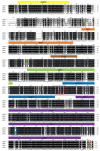A Porcine DNMT1 Variant: Molecular Cloning and Generation of Specific Polyclonal Antibody
- PMID: 37510229
- PMCID: PMC10379332
- DOI: 10.3390/genes14071324
A Porcine DNMT1 Variant: Molecular Cloning and Generation of Specific Polyclonal Antibody
Abstract
DNA methyltransferase 1 (DNMT1), the first-identified DNA methyltransferase in mammals, has been well studied in the control of embryo development and somatic homeostasis in mice and humans. Accumulating reports have demonstrated that DNMT1 plays an important role in the regulation of differentiation and the activation of immune cells. However, little is known about the effects of porcine DNMT1 on such functional regulation, especially the regulation of the biological functions of immune cells. In this study, we report the cloning of DNMT1 (4833 bp in length) from porcine alveolar macrophages (PAMs). According to the sequence of the cloned DNMT1 gene, the deduced protein sequence contains a total of 1611 amino acids with a 2 amino acid insertion, a 1 amino acid deletion, and 12 single amino acid mutations in comparison to the reported DNMT1 protein. A polyclonal antibody based on a synthetic peptide was generated to study the expression of the porcine DNMT1. The polyclonal antibody only recognized the cloned porcine DNMT1 and not the previously reported protein due to a single amino acid difference in the antigenic peptide region. However, the polyclonal antibody recognized the endogenous DNMT1 in several porcine cells (PAM, PK15, ST, and PIEC) and the cells of other species (HEK-293T, Marc-145, MDBK, and MDCK cells). Moreover, our results demonstrated that all the detected tissues of piglet express DNMT1, which is the same as that in porcine alveolar macrophages. In summary, we have identified a porcine DNMT1 variant with sequence and expression analyses.
Keywords: DNMT1; polyclonal antibody; porcine alveolar macrophages; synthetic peptide.
Conflict of interest statement
The authors declare no conflict of interest.
Figures




Similar articles
-
Gene expression of Dnmt1 isoforms in porcine oocytes, embryos, and somatic cells.Cell Reprogram. 2013 Aug;15(4):309-21. doi: 10.1089/cell.2012.0088. Epub 2013 Jun 28. Cell Reprogram. 2013. PMID: 23808878 Free PMC article.
-
Xenopus eggs express an identical DNA methyltransferase, Dnmt1, to somatic cells.J Biochem. 2001 Sep;130(3):359-66. doi: 10.1093/oxfordjournals.jbchem.a002994. J Biochem. 2001. PMID: 11530011
-
Gene expression pattern and downregulation of DNA methyltransferase 1 using siRNA in porcine somatic cells.Gene Expr. 2009;14(5):251-63. doi: 10.3727/105221609788681222. Gene Expr. 2009. PMID: 19630269 Free PMC article.
-
DNMT1: catalytic and non-catalytic roles in different biological processes.Epigenomics. 2022 May;14(10):629-643. doi: 10.2217/epi-2022-0035. Epub 2022 Apr 12. Epigenomics. 2022. PMID: 35410490 Review.
-
DNA methyltransferase-1 in acute myeloid leukaemia: beyond the maintenance of DNA methylation.Ann Med. 2022 Dec;54(1):2011-2023. doi: 10.1080/07853890.2022.2099578. Ann Med. 2022. PMID: 35838271 Free PMC article. Review.
References
-
- Jain D., Meydan C., Lange J., Claeys Bouuaert C., Lailler N., Mason C.E., Anderson K.V., Keeney S. rahu is a mutant allele of Dnmt3c, encoding a DNA methyltransferase homolog required for meiosis and transposon repression in the mouse male germline. PLoS Genet. 2017;13:e1006964. doi: 10.1371/journal.pgen.1006964. - DOI - PMC - PubMed
Publication types
MeSH terms
Substances
LinkOut - more resources
Full Text Sources
Miscellaneous

